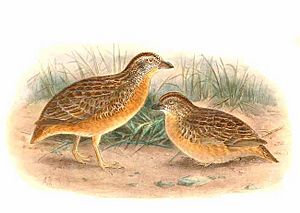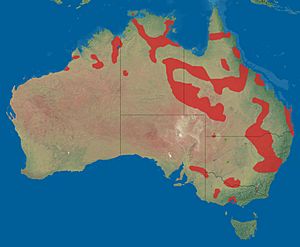Red-chested buttonquail facts for kids
Quick facts for kids Red-chested buttonquail |
|
|---|---|
 |
|
| Conservation status | |
| Scientific classification | |
| Genus: |
Turnix
|
| Species: |
pyrrhothorax
|
 |
|
| The Distribution of the red-chested buttonquail. Green denotes vagrant records | |
The red-chested buttonquail (Turnix pyrrhothorax) is a small bird that lives on the ground. It is part of the buttonquail family and is found only in Australia. These birds are usually seen across New South Wales, Queensland, northern Western Australia, and the Northern Territory. However, they are considered vulnerable in Victoria.
This bird is reddish-brown and prefers to run on the ground rather than fly. The female red-chested buttonquail is brighter in color and a bit larger than the male. Interestingly, the female is polyandrous, which means she will court several males and chase away other females from her area.
Contents
About the Red-chested Buttonquail
The red-chested buttonquail was first described by a bird expert named John Gould in 1841. He found it near Aberdeen, New South Wales, Australia. He first called it Hemipodius pyrrhothorax.
This bird belongs to the Turnicidae family. Even though they look like quails, they are not related to them. There are 17 different species in the buttonquail family. The red-chested buttonquail is part of the Turnix group.
What Does It Look Like?
Adult red-chested buttonquails are about 12 to 16 centimeters (5 to 6 inches) long. Males weigh between 27 and 46 grams, while females are a bit heavier, weighing 31 to 83 grams. They are smaller than the painted button-quail.
From behind, they look light grey on their upper wings and back. From the side, you can see a reddish-brown color on their upper parts. If you get close, you might notice their thick blue-grey beak, pink legs and feet, and light-colored eyes.
Female birds are more colorful than males. Their reddish-brown color on their belly extends up to their throat and sides of their head. Young birds are smaller and darker, with white stripes and spots.
These birds are often seen in woodlands more than grasslands. If they get scared, they will quickly run through the grass or fly low with fast-beating wings. They usually show their white sides before dropping back into cover. They generally like to stay on the ground and avoid flying.
Similar Birds
The red-chested buttonquail can be recognized by its even grey-brown color on top and orange-chestnut patches.
- The Little buttonquail (Turnix velox) has a reddish-brown or pinkish belly and different colors on its wings.
- The Red-backed buttonquail (Turnix maculosus) has a darker grey or blackish color on top and dark underparts, except for a lighter patch on its wing.
Where They Live
Red-chested buttonquails are found along the eastern side of Australia. They also live in the northern parts of the Northern Territory and Western Australia. You won't find them in Tasmania.
They prefer to live in thick grasslands and open woodlands. These woodlands often have Acacia trees, River Red Gum trees, Black box trees, or Melaleuca plants. They can also be found in farm fields with lots of ground cover. They live from sea level up to 1000 meters high.
They usually like places with more moisture and thicker plants than the little buttonquail. However, they can also live in dry areas. What they all seem to need is bare ground, lots of fallen leaves, very few small bushes, and patches of tall grass or sedges. They usually look for food in open areas with deep leaf litter. If they feel threatened, they hide in tall grass or under woody debris.
How They Behave
What They Eat
Red-chested buttonquails eat seeds from grasses and other plants like Triticum, Panicum, and Malvaceae. They also eat insects such as cockroaches, ants, flies, and their larvae. They look for food throughout the day.
When they search for food, they make small scrapes in the ground. They do this by pivoting on one foot and raking the ground with the other. Sometimes, in dry weather, you can see small puffs of dust when they do this. They have been seen feeding alone, in pairs, or in small groups of up to five birds.
Reproduction and Life Cycle
These birds build their nests in tall grasslands, spinifex, or Melaleuca woodlands. They also nest in native grass pastures and farm fields. Red-chested buttonquails are solitary breeders. The female is polyandrous, meaning she mates with several males.
The female usually builds the nest. It's a shallow dip in the ground lined with grass and hidden by a clump of grass. Eggs are laid from February to July or September in the north, and from September to February in the south. Usually, four white eggs with chestnut-brown markings are laid every one or two days. The male bird incubates the eggs for 13 to 18 days. He also takes care of the chicks by himself.
The chicks leave the nest soon after hatching. They are grey-brown with dark and light stripes on their backs. They grow to adult size in 6 to 8 weeks and get their adult feathers in 2 to 3 months. They can start having their own chicks when they are 6 months old.
Sounds They Make
The female red-chested buttonquail makes a repeating "oom" sound to attract mates. This sound gets higher in pitch and louder. If a bird is disturbed, it makes a sharp chattering sound. Adult birds also make soft whistles and chirps to talk to each other. Young birds make a weak, chicken-like sound if someone handles them.
Migration
Some red-chested buttonquails migrate, meaning they move from one place to another. They are known to move seasonally from dry inland areas to semi-dry coastal areas, especially from winter to spring and summer. However, some groups of these birds stay in the same area all year round. How much they move depends on things like rainfall, plant growth, and how much food is available.
In Captivity
When kept in captivity, if their enclosure is too small, red-chested buttonquails can become aggressive. Males might fight other males' offspring. Females might even kill the offspring of other females so that the male will mate with them again.
Protecting the Red-chested Buttonquail
The red-chested buttonquail is listed as a Least Concern species by the IUCN. This means they are not currently in danger of disappearing. It is not listed as threatened by Australia's main environmental law. However, its protection status changes from state to state in Australia. For example, it is listed as "threatened" in Victoria.
This species is thought to be uncommon but safe in most of Australia. In the past, people hunted these birds for food and sport. They were also sometimes killed by wild animals like cats and foxes. The biggest threat to these birds now is losing their homes. This is because their natural grasslands are being turned into farms. Red-chested buttonquails that nest in farm fields can lose their eggs when crops are harvested.
The number of these birds varies. In the northern parts of Australia, they are common. But in much of Queensland, especially near the coast, they are spread out. In the southern parts of Australia, their numbers are going down. They are very uncommon in South Australia, rarely seen in New South Wales, and very few are left in Victoria. The decline in Victoria is mostly because 95% of their native grasslands have been destroyed or damaged for farming.
Things like livestock grazing, growing crops, and removing woody debris for firewood are also threats to the red-chested buttonquail. To help these birds, we need to manage their habitats carefully. This means protecting their ground covers, tall grass, sedges, and woody debris to make sure they have suitable places to live.
Images for kids
See also
 In Spanish: Torillo pechirrufo para niños
In Spanish: Torillo pechirrufo para niños




